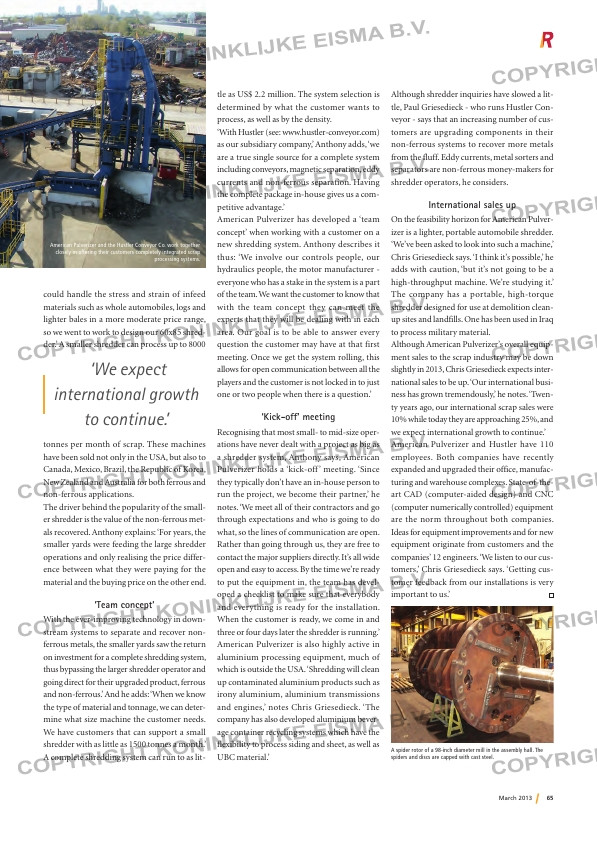Page 65 from: March 2013

65March 2013
could handle the stress and strain of infeed
materials such as whole automobiles, logs and
lighter bales in a more moderate price range,
so we went to work to design our 60×85 shred-
der.’ A smaller shredder can process up to 8000
tonnes per month of scrap. These machines
have been sold not only in the USA, but also to
Canada, Mexico, Brazil, the Republic of Korea,
New Zealand and Australia for both ferrous and
non-ferrous applications.
The driver behind the popularity of the small-
er shredder is the value of the non-ferrous met-
als recovered. Anthony explains: ‘For years, the
smaller yards were feeding the large shredder
operations and only realising the price differ-
ence between what they were paying for the
material and the buying price on the other end.
‘Team concept’
With the ever-improving technology in down-
stream systems to separate and recover non-
ferrous metals, the smaller yards saw the return
on investment for a complete shredding system,
thus bypassing the larger shredder operator and
going direct for their upgraded product, ferrous
and non-ferrous.’ And he adds: ‘When we know
the type of material and tonnage, we can deter-
mine what size machine the customer needs.
We have customers that can support a small
shredder with as little as 1500 tonnes a month.’
A complete shredding system can run to as lit-
tle as US$ 2.2 million. The system selection is
determined by what the customer wants to
process, as well as by the density.
‘With Hustler (see: www.hustler-conveyor.com)
as our subsidiary company,’ Anthony adds, ‘we
are a true single source for a complete system
including conveyors, magnetic separation, eddy
currents and non-ferrous separation. Having
the complete package in-house gives us a com-
petitive advantage.’
American Pulverizer has developed a ‘team
concept’ when working with a customer on a
new shredding system. Anthony describes it
thus: ‘We involve our controls people, our
hydraulics people, the motor manufacturer –
everyone who has a stake in the system is a part
of the team. We want the customer to know that
with the team concept they can meet the
experts that they will be dealing with in each
area. Our goal is to be able to answer every
question the customer may have at that first
meeting. Once we get the system rolling, this
allows for open communication between all the
players and the customer is not locked in to just
one or two people when there is a question.’
‘Kick-off’ meeting
Recognising that most small- to mid-size oper-
ations have never dealt with a project as big as
a shredder system, Anthony says, American
Pulverizer holds a ‘kick-off ’ meeting. ‘Since
they typically don’t have an in-house person to
run the project, we become their partner,’ he
notes. ‘We meet all of their contractors and go
through expectations and who is going to do
what, so the lines of communication are open.
Rather than going through us, they are free to
contact the major suppliers directly. It’s all wide
open and easy to access. By the time we’re ready
to put the equipment in, the team has devel-
oped a checklist to make sure that everybody
and everything is ready for the installation.
When the customer is ready, we come in and
three or four days later the shredder is running.’
American Pulverizer is also highly active in
aluminium processing equipment, much of
which is outside the USA. ‘Shredding will clean
up contaminated aluminium products such as
irony aluminium, aluminium transmissions
and engines,’ notes Chris Griesedieck. ‘The
company has also developed aluminium bever-
age container recycling systems which have the
flexibility to process siding and sheet, as well as
UBC material.’
Although shredder inquiries have slowed a lit-
tle, Paul Griesedieck – who runs Hustler Con-
veyor – says that an increasing number of cus-
tomers are upgrading components in their
non-ferrous systems to recover more metals
from the fluff. Eddy currents, metal sorters and
separators are non-ferrous money-makers for
shredder operators, he considers.
International sales up
On the feasibility horizon for American Pulver-
izer is a lighter, portable automobile shredder.
‘We’ve been asked to look into such a machine,’
Chris Griesedieck says. ‘I think it’s possible,’ he
adds with caution, ‘but it’s not going to be a
high-throughput machine. We’re studying it.’
The company has a portable, high-torque
shredder designed for use at demolition clean-
up sites and landfills. One has been used in Iraq
to process military material.
Although American Pulverizer’s overall equip-
ment sales to the scrap industry may be down
slightly in 2013, Chris Griesedieck expects inter-
national sales to be up. ‘Our international busi-
ness has grown tremendously,’ he notes. ‘Twen-
ty years ago, our international scrap sales were
10% while today they are approaching 25%, and
we expect international growth to continue.’
American Pulverizer and Hustler have 110
employees. Both companies have recently
expanded and upgraded their office, manufac-
turing and warehouse complexes. State-of-the-
art CAD (computer-aided design) and CNC
(computer numerically controlled) equipment
are the norm throughout both companies.
Ideas for equipment improvements and for new
equipment originate from customers and the
companies’ 12 engineers. ‘We listen to our cus-
tomers,’ Chris Griesedieck says. ‘Getting cus-
tomer feedback from our installations is very
important to us.’
‘We expect
international growth
to continue.’
American Pulverizer and the Hustler Conveyor Co. work together
closely in offering their customers completely integrated scrap
processing systems.
A spider rotor of a 98-inch diameter mill in the assembly hall. The
spiders and discs are capped with cast steel.
RI_2-Supplier.indd 65 06-03-13 09:18



